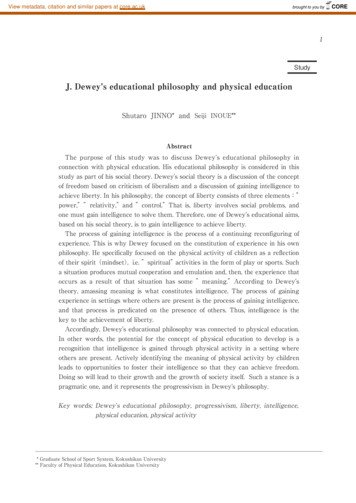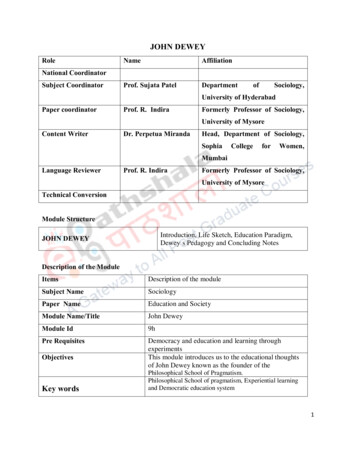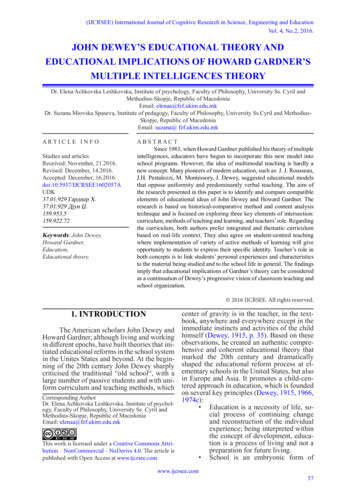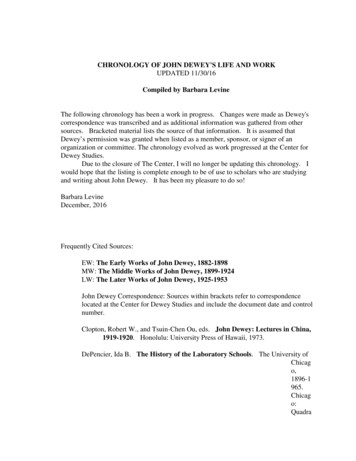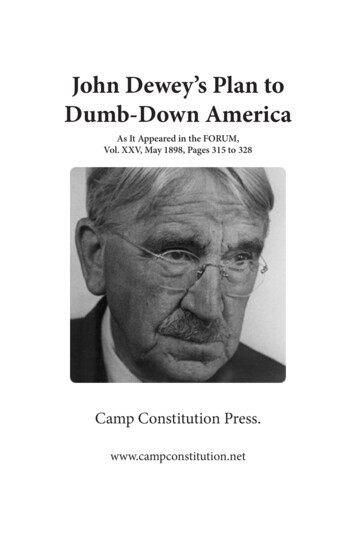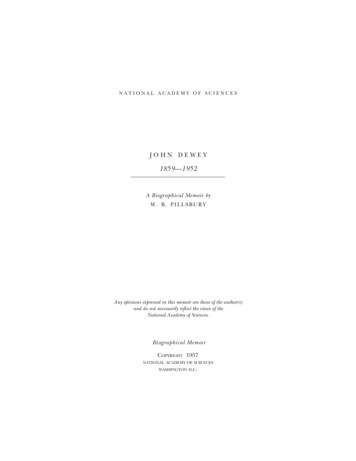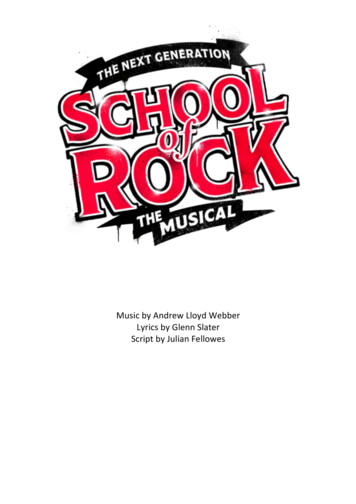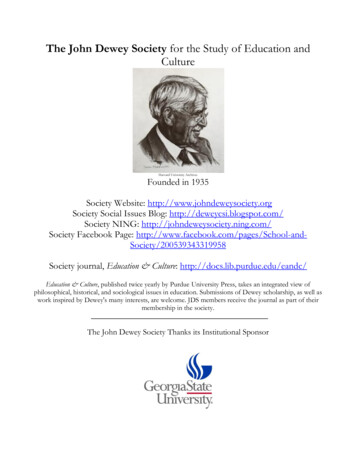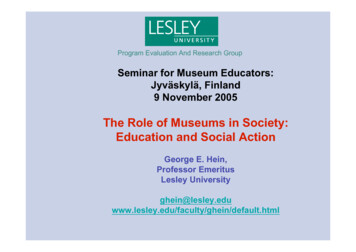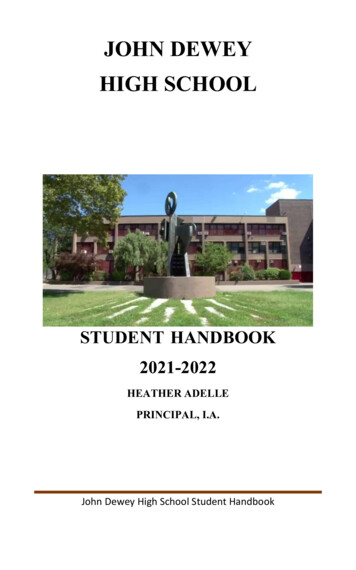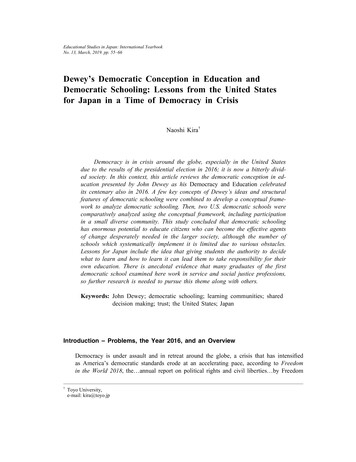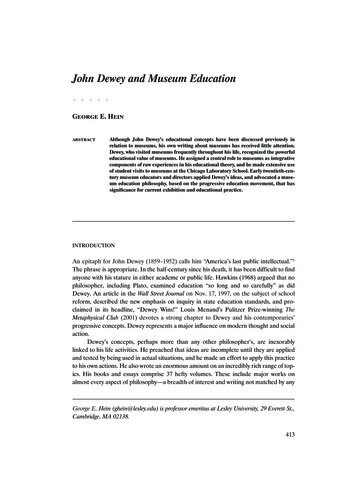
Transcription
47/4 Oct issue 365-4689/16/045:12 PMPage 413John Dewey and Museum Education GEORGE E. HEINABSTRACTAlthough John Dewey’s educational concepts have been discussed previously inrelation to museums, his own writing about museums has received little attention.Dewey, who visited museums frequently throughout his life, recognized the powerfuleducational value of museums. He assigned a central role to museums as integrativecomponents of raw experiences in his educational theory, and he made extensive useof student visits to museums at the Chicago Laboratory School. Early twentieth-century museum educators and directors applied Dewey’s ideas, and advocated a museum education philosophy, based on the progressive education movement, that hassignificance for current exhibition and educational practice.INTRODUCTIONAn epitaph for John Dewey (1859–1952) calls him “America’s last public intellectual.”1The phrase is appropriate. In the half-century since his death, it has been difficult to findanyone with his stature in either academe or public life. Hawkins (1968) argued that nophilosopher, including Plato, examined education “so long and so carefully” as didDewey. An article in the Wall Street Journal on Nov. 17, 1997, on the subject of schoolreform, described the new emphasis on inquiry in state education standards, and proclaimed in its headline, “Dewey Wins!” Louis Menand’s Pulitzer Prize-winning TheMetaphysical Club (2001) devotes a strong chapter to Dewey and his contemporaries’progressive concepts. Dewey represents a major influence on modern thought and socialaction.Dewey’s concepts, perhaps more than any other philosopher’s, are inexorablylinked to his life activities. He preached that ideas are incomplete until they are appliedand tested by being used in actual situations, and he made an effort to apply this practiceto his own actions. He also wrote an enormous amount on an incredibly rich range of topics. His books and essays comprise 37 hefty volumes. These include major works onalmost every aspect of philosophy—a breadth of interest and writing not matched by anyGeorge E. Hein (ghein@lesley.edu) is professor emeritus at Lesley University, 29 Everett St.,Cambridge, MA 02138.413
47/4 Oct issue 365-4689/16/044145:12 PMPage 414HEIN JOHN DEWEY AND MUSEUM EDUCATIONother modern philosopher.2 In addition, he created countless essays on philosophicaltopics and social and political issues. Dewey wrote and spoke out on every conceivablesubject of public interest.His works are components of a complex philosophical vision.3 One example isDewey’s broad definition and use of the term “experience.” Not only does this wordappear in the title of three major works, Experience and Nature, Art as Experience, andExperience and Education, but Dewey had such a complex meaning for “experience” thathe considered replacing it with “culture” in a revision of Experience and Nature (seeWestbrook 1991, 345–46.)Dewey’s philosophical positions were always intended to be consistent with hismoral and social views—what he called democratic, progressive concepts. In his carefully structured philosophical work, he constantly attempted to achieve a balance of ideas toavoid the dualisms that have proven to be so problematic to philosophers: the Cartesianseparation of mind and body, for example, or the distinction between fine and appliedarts. He repeatedly demonstrated that these distinctions lead to hierarchies of value (inthe case of Cartesian dualism, the valuing of thought over action.) At the same time, heconsistently exerted himself to promote democratic progressive practices—tolerance,civil liberties, acceptance of immigrants, and economic reform (meaning decreasing disparity between the rich and the poor)—through political and social action.A recent resurgence of interest in Dewey’s life and work has had an effect on museum education literature. Cole points out that constructivism has its roots in Dewey’swork because he recognized prior knowledge and experience as the basis for meaningmaking (1985; 1995). Rochelle recognizes that Dewey’s comprehensive definition of“experience” includes more than the empiricist notion of sensory input (1995). Ansbacher, focusing primarily on Dewey’s Experience and Education, has stressed the need forexhibition developers to concentrate on the actual experience that visitors have withexhibitions, rather than looking only at the later outcome of “learning” (1998; 1999).Hennes has broadened the discussion to include Dewey’s references to inquiry and hisconcept of the continuity of experience (2002).But Dewey’s own love of museums and his views of museums as educational entities have not received much attention. These topics are examined in this paper; they suggest the ongoing relevance of applying Dewey’s educational philosophy to museums.DEWEY ON MUSEUMSMuseums were important to Dewey, and he enjoyed visiting them throughout his life.When the Dewey family moved from Ann Arbor to Chicago in 1894, he went ahead tofind a house to live in and to prepare for a demanding position in this new university (thefirst classes had been held only two years previously) as the first chairman of a philosophydepartment that included psychology and pedagogy. His wife Alice and two older children were in Europe, while the youngest child remained behind with Alice’s parents. Thevoluminous family correspondence during this separation includes details of his daily life414
47/4 Oct issue 365-4689/16/045:12 PMPage 415CURATOR 47/4 OCTOBER 2004415as well as notes to the children and concerns about other family matters. It also containsfrequent mention of museums. Within the first month in Chicago, Dewey found time tovisit both the Columbian Museum (now the Field Museum of Natural History) and theArt Institute. In early August, he wrote, “I haven’t been invited out today and am goingto see the Columbian Museum, as it’s a ‘free’ day—alone and great will be the joy thereof” (Dewey 1894).The theme of museum visitation continues as a constant thread throughout his correspondence. His many trips both within the U.S. and overseas usually included “a rigorous schedule of museum visits, occasionally interrupted by social occasions” (Martin2002, 352). For example, on his way to the Soviet Union in 1928 with a group of educatorsto visit schools at the invitation of the Soviet Minister of Education, Dewey left early andwent first to London and Paris, mainly to visit museums. (He was accompanied by hisdaughter-in-law Elizabeth; his wife had died the previous year.) About their time in London, he wrote, “We haven’t done such a lot of sightseeing, but we have spent about twohours in the picture galleries every day continuing our art education—its [sic] astonishinghow much there is to see each time that one never saw before” (Dewey 1928a). FromParis, he wrote to his close friend and colleague George Mead, “Our serious occupationis pictures, in which we are both interested. In fact I think I’m more interested in themthan anything else outside of philosophy, and we have both been educated a la Barnesand our tastes agree” (Dewey 1928b).4THE EDUCATIONAL ROLE OF MUSEUMSDewey first elucidated the role of museums in his overall education scheme in The Schooland Society, a series of lectures delivered in 1899, shortly after he founded his Laboratory School (Dewey 1900). Dewey laid out a model plan for a school—describing it both inwords and illustrations—and included charts that represented “not our architect’s planfor the school building we hope to have; but . . . a diagrammatic representation of theidea which we want embodied in the school building” (1900, 79).These charts are instructive of Dewey’s pedagogic ideas and the connections hedrew between school subjects and life activities. A first chart (not reproduced here) outlines the phases of education, from kindergarten through post-secondary opportunities.Chart II (figure 1) emphasizes that the school should be connected with life outside, notisolated from it—a theme that persists throughout Dewey’s writing. He stated that hewished “to suggest that really the only way to unite the parts of the system is to unite eachwith life” (Dewey 1900, 72). Chart III (figure 2), symbolic of the lower level of the school,shows school activities (that are not traditional curriculum subjects) connected to lifepursuits and all opening up to the library in the center. He described the relationship:The center represents the manner in which all come together in the library; that is to say,in a collection of the intellectual resources of all kinds that throw light upon the practical work, that give it meaning and liberal value. If the four corners represent practice,415
47/4 Oct issue 365-4684169/16/045:12 PMPage 416HEIN JOHN DEWEY AND MUSEUM EDUCATIONFigure 1. Dewey's conception of the unity of school and life. From Dewey, The Schooland Society (1900, p. 73). Reproduced by permission, University of Chicago Press.the interior represents the theory of the practical activities. In other words, the object ofthese forms of practice in the school is not found chiefly in themselves, or in the technical skills of cooks, seamstresses, carpenters, and masons, but in their connection, on thesocial side, with the life without; while on the individual side they respond to the child’sneed of action, of expression, of desire to do something, to be constructive and creative,instead of simply passive and conforming. Their great significance is that they keep thebalance between the social and individual sides—the chart symbolizing particularly theconnection with the social (Dewey 1900, 79–80).Dewey continued to elaborate the relationship between the activities and the library:If you imagine rooms half in the four corners and half in the library, you will get the ideaof the recitation room. That is the place where the children bring the experiences, theproblems, the questions, the particular facts which they have found, and discuss them sothat new light may be thrown upon them, particularly new light from the experience ofothers, the accumulated wisdom of the world—symbolized in the library. Here is theorganic relation of theory and practice; the child not simply doing things, but gettingalso the idea of what he does; getting from the start some intellectual conception thatenters into his practice and enriches it; while every idea finds, directly or indirectly, some416
47/4 Oct issue 365-4689/16/045:12 PMPage 417CURATOR 47/4 OCTOBER 2004417Figure 2. Dewey's representation of the ground floor of his ideal school. From Dewey, TheSchool and Society (1900, p. 81). Reproduced by permission, University of Chicago Press.application in experience, and has some effect upon life. This, I need hardly say, fixesthe position of the “book” or reading in education. Harmful as a substitute for experience, it is all-important in interpreting and expanding experience (Dewey 1900, 85).Museums as well as libraries function as intellectual centers for developing thework that occurs in the “corners,” as seen in Chart IV (figure 3). The upper floor of theschool grows out of the lower one; the topical areas are now translated into school subjects; the shop gives rise to natural sciences; the kitchen to biological sciences; and artand music develop from their artisan roots. Dewey explains this:The other chart [Chart IV] illustrates precisely the same idea. It gives the symbolicupper story of this ideal school. In the upper corners are the laboratories; in the lowercorners are the studios for art work, both the graphic and auditory arts. The questions,the chemical and physical problems, arising in the kitchen and shop, are taken to thelaboratories to be worked out. . . .The drawing and music, or the graphic and auditory arts, represent the culmination,the idealization, the highest point of refinement of all the work carried on. I think everybody who has not a purely literary view of the subject recognizes that genuine art growsout of the work of the artisan (Dewey 1900, 85–86).Using the example of art as a model for describing the organization of the school, Deweysays in a grand summary statement:417
47/4 Oct issue 365-4689/16/044185:12 PMPage 418HEIN JOHN DEWEY AND MUSEUM EDUCATIONFigure 3. The symbolic upper story of Dewey's ideal school. From Dewey, The Schooland Society (1900, p. 87). Reproduced by permission, University of Chicago Press.[The school] is a living union of thought and the instrument of expression. This union issymbolized by saying that in the ideal school the art work might be considered to be thatof the shops, passed through the alembic of library and museum into action again(Dewey 1900, 89).5The same conception would apply to science and history. As he says further on:Thus I have attempted to indicate how the school may be connected with life so that theexperience gained by the child in a familiar, commonplace way is carried over and madeuse of there, and what the child learns in the school is carried back and applied in everydaylife, making the school an organic whole, instead of a composite of isolated parts. The isolation of studies as well as of parts of the school system disappears. Experience has its geographical aspect, its artistic and its literary, its scientific and its historical sides. All studiesarise from aspects of the one earth and the one life lived upon it (Dewey 1900, 91).I have quoted this section at length because it illustrates Dewey’s ideas as they relatelibraries and museums to life experiences in education. In all these passages, Dewey consistently described the ideal school as an institution that includes libraries and museums inan organic whole in which life-experiences and specialized experiences such as readingand museum visits are unified. The “experience” in museums is valuable, but, by itself, itisn’t a complete life-experience. Like knowledge in books, it may be “harmful as a substitute for experience,” but “all-important in interpreting and expanding experience.”His view that museums should be part of the active learning network of any school isreinforced by other references to museums in his writings. For example, in an earlier mes418
47/4 Oct issue 365-4689/16/045:12 PMPage 419CURATOR 47/4 OCTOBER 2004419sage to parents about the status of the emerging school, Dewey referred to his efforts toavoid certain dualisms and emphasized using museums among other educational resources:Already we have much help from the university in scientific work planned, sometimeseven in detail, by heads of departments. The graduate student comes to us with hisresearches and methods, suggesting ideas and problems. The library and museum are athand. We want to bring all things educational together; to break down the barriers thatdivide the education of the little child from the instruction of the maturing youth; toidentify the lower and the higher education, so that it will be demonstrated to the eyethat there is no lower and higher, but simply education (Dewey 1897).The theme of the library and museum as central both conceptually and practically comesup again in the actual plan for a School of Education building, completed after Deweyleft Chicago for New York. The building floor plans are based on his previous theoreticalmodel.The space on the third floor immediately over the library has been assigned to the museum. The museum shall be used largely for practical work in connection with all thedepartments of the school. Adjoining the museum on the west are two rooms for biology, one for elementary, the other for advanced pupils (Dewey 1904, 343).These same themes continue in Dewey’s writing over many years: museums shouldbe an integral part of any educational setting, and the most desirable museums are thosethat are used for educational purposes and are associated with life activities outside of themuseum. After visiting Turkey as a guest of the new republican government, he was muchimpressed with the archeological work there and urged that a department of archeologybe established at the University of Constantinople with close connections to a museumboth for display and education (Dewey 1924a). His recommendations to the Turkish government include advice familiar to any reader of The School and Society: that a schoolbuilding needs to reflect the educational program and, thus, needs to include a museum.The construction of the school building bears closer relation to the kind of instructiongiven, and the methods of school discipline and instruction, than is usually believed. . . . 6No steady development of progressive education is possible without buildings whichhave proper sanitary and toilet facilities, places for manual training, domestic science,drawing and art, library, museum etc. (Dewey 1924b).In his lengthy report on his visit to the Soviet Union he mentions that:The best museum of natural history and social materials for pedagogical purposes I haveever seen is in a country district outside of Leningrad, constructed on the basis of a complete exhibit of local fauna, flora, mineralogy, etc., and local antiquities and history,made by pupils’ excursions under the direction of their teachers (Dewey 1928c).419
47/4 Oct issue 365-4689/16/044205:12 PMPage 420HEIN JOHN DEWEY AND MUSEUM EDUCATIONThis story neatly illustrates Dewey’s conception of museum use. This museum isexemplary not because of the strength of the collection, but because it comes from thelocal life outside the school and has been used to organize and analyze the results of experience. Museums should grow out of life experiences and be used to reflect back on life.For Dewey, regular museum visits, along with other kinds of field trips, were a component of the educational program, not a special once-a-year activity. In writing to aprospective teacher he hoped to hire at the laboratory school, he described her duties asfollows:Begin work after New Years on the basis of about 25 children between the ages of 6 & 9,. . . I don’t know just what to say about hours, from 9–12 in the morning, but some afternoons a week to be given to going to see the country about, visit the museums &c(Dewey 1895).The Laboratory School did indeed include extensive use of museums. Besides visits tothe university museum, mentioned previously, children from the school went to the FieldColumbian Museum (at that time close to the school at the site of the present ChicagoMuseum of Science and Industry) for an hour and a half every week. This was part of anextensive program of excursions to connect school life with the world outside.During 1896–97, an hour and a half was set aside on Monday mornings for trips to theField Columbian Museum. . . . The younger children had a plot of ground. . . where theyoften went to observe seasonal changes in nature. Older children went to the universitylaboratories to see such instruments as the interferometer and spectroscope. Therewere also longer trips—to the quarry on Stoney Island where glacial markings wereobserved, to the cotton mills in Aurora to see the spinning of cotton, and others toRavinia to see the clay bluffs, to Miller Station to see the sand dunes and desert and toSixty-third street and the city limits to see a typical prairie area (DePencier 1967, 33).Dewey’s clear sense of the educational potential of museums can also be seen fromhis critical remarks about some museums. Dewey criticized traditional museums much ashe criticized traditional schools. He recognized that in the public mind, museums, likeschools, are seen as dusty places filled with rows of objects, neatly catalogued but devoidof the interactions that animate knowledge. Art as Experience contains some of his betterknown passages in reference to many art museums:The arts which today have most vitality for the average person are things he does nottake to be arts: for instance, the movie, jazzed music, the comic strip, and, too frequently, newspaper accounts of love-nests, murders, and exploits of bandits. For, when whathe knows as art is relegated to the museum and gallery, the unconquerable impulsetowards experiences enjoyable in themselves finds such outlet as the daily environmentprovides. Many a person who protests against the museum conception of art, still shares420
47/4 Oct issue 365-4689/16/045:12 PMPage 421CURATOR 47/4 OCTOBER 2004421the fallacy from which that conception springs. For the popular notion comes from aseparation of art from the objects and scenes of ordinary experience that many theoristsand critics pride themselves upon holding and even elaborating (Dewey 1934, 6).He goes on to comment that art museums are primarily the product of the capitalist urge to show off wealth, with the result that the fine arts have been separated from therest of life and cloistered in selected, inaccessible places. The problem is once again adestructive dualism: the separation of fine arts from practical arts, of art and its appreciation from other life activities, and the gap between museum exhibitions and populareducation.7It is worth pointing out that at the time Dewey was taking the children to the FieldColumbian Museum on a regular basis, some museum administrators did not see muchuse for such visits. George Brown Goode, often regarded as the advocate for the educational role of museums (Zeller 1989a), proclaimed:I should not organize museums primarily for the use of people in their larval or schoolgoing stage of existence . . . before their minds have reached the stage of growth favorable for the reception and assimilation of the best and most useful thought (Goode1887/1991).PROGRESSIVE EDUCATION AND MUSEUM EDUCATIONAt the same time that Dewey was working to integrate life experiences and educationalactivities in schools, museum education was developing as an active component of American museums. The Brooklyn Children’s Museum was founded in 1899 as the BrooklynInstitute of Arts and Sciences. John Cotton Dana began his work in Newark in 1902;after the Newark Museum was founded in 1909, he served as director until 1929. Otherswere developing the educational and social role of the museum early in the twentiethcentury. These “Innovators and Pioneers” (Alexander 1997) recognized the progressiveeducation agenda as the appropriate model for their efforts and referred to it frequently.Dana’s writings, long inaccessible, have recently been republished (Peniston 1999).They include a startling similarity to Dewey’s own words. Dana also decried the elitistnature of current museums. He had little appreciation for “temples” devoted to the visual arts and proposed branch museums for every school, as well as in churches and factories. Dana expressed his views forcefully:Our own modest experience in this type of school museum in Newark has led us to theconclusion that a collection of objects costing, say, 1,000, plus the activities of a groupof museum workers costing 10,000 per year, would be of far more value to a community, chiefly through its use by schools, than would a collection which cost 100,000 and ismerely presided over in the ancient manner by a few curators (Peniston 1999, 193).421
47/4 Oct issue 365-4689/16/044225:12 PMPage 422HEIN JOHN DEWEY AND MUSEUM EDUCATIONDana constantly stressed the need for the museum to serve the community—toconnect what occurred in the museum with the life of the society—and he emphasizedlearning from the ordinary objects created by workers of his predominantly immigrantcity. Photographs of the museum’s outdoor activities for children or the demonstrationof weaving sponsored by the Newark Museum look very much like the pictures of children planting their garden or working in the textile shop at the Laboratory School inChicago.8In 1913, Dana sent Louise Connolly, a former teacher and superintendent inNew Jersey and then “educational expert” at the Newark Free Public Library, on twotrips to museums across the United States to see what they were doing in education.Her first journey was up and down the East Coast; the second took her as far west asDetroit. Her report provides a ringing endorsement of progressive education and therole that museums could play in this experience-based educational movement (Connolly 1914). She also echoes Dewey’s concept that museums need to be associated withlife experiences. In a section entitled “Good Museums Waited on Good Teaching,” shedescribes the impact of progressive education ideas on pedagogy and their applicationto museums:Then came the modern movement in pedagogy. It took off the shackles of dead formsthat had trammeled the feet of teachers, and bade them walk. Some do not know to thisday that their feet are free; but many are treading with firm step the uphill path thatleads to high achievement just because they know enough to study the child as well asthe subject . . . .So we take out children to see the real thing, whatever that may be, and then to themuseum where hand specimens of it may be found to remind us of it, and then wereduce our knowledge of it to language, and, finally, we look into books to be remindedby language of our experience-gained knowledge.The whole city administration in any progressive city is a museum. A class recitingupon the function of courts has seen a court in session. The city itself is a still larger andfuller museum. A class desiring to sketch trees sits in the park or on its school-housedoorstep for the lesson. A class in United States history gathers about the statue ofWashington. Rivers are studied on a river’s brink.So through their own observation of the response given to their efforts and throughthe diffusion of ideas as to how the people should be taught, museums have been slowlyled to the revolution which is now going on in their conduct (Connolly 1914, 6–8).At about the same time, a number of school districts experimented with schoolmuseums, and other museums accepted the social role championed by Dana andDewey’s experiential learning model. For example, the St. Louis public schools, underthe direction of C. G. Rathmann (1915), developed a particularly extensive collection ofmuseum objects to lend to schools, a practice that became a model for other efforts(Zucker 1989). In Rochester, Arthur C. Parker “saw museums as places of discovery . . .where John Dewey’s philosophy of learning by doing received direct application” (Zeller422
47/4 Oct issue 365-4689/16/045:12 PMPage 423CURATOR 47/4 OCTOBER 20044231989). The Brooklyn Children’s Museum’s progressive education efforts influencedmany other museum education departments (Alexander 1997). Progressive educators, inturn, copied the work of museums. Their students built things, learned from objects, wenton field trips, and even developed exhibitions.9That Dewey and Dana expressed such similar views can be explained at least inpart by their common allegiance to progressive principles. The progressive movement, atits height in the early twentieth century, was of course much broader and more complexthan its manifestation in the educational domain. Progressives urged wide-rangingreforms to address social problems associated with urbanization, immigration, and industrialization. Public institutions, including schools and libraries, grew rapidly as reformerssucceeded in forcing local and state governments to assume greater responsibility for andoversight of education, health and other social service functions.10The notion that museums could play a role in the emerging and rapidly expandingpublic education system was also not unique to Dewey and Dana, but a common earlytwentieth-century concept. The idea that museums were inherently educational goesback to the birth of the modern museum during the eighteenth-century Enlightenmentand was constantly stressed throughout the nineteenth century (Hein, in press).But Dewey’s contribution is still impressive. Just as his Laboratory School becamethe model and symbol for the progressive schools that followed, so his championing ofthe particular educational role of museums—and the application of that view to his ownpractice—can serve as a model for museum education.CONCLUSIONDewey considered museums to be institutions that he personally enjoyed and visitedoften, as an integral part of the rich life experiences that contribute to education. Butmuseum experiences, even active ones, still need to be associated with richer, authenticlife experiences. Dewey believed that people learned in museums, just as they can learnin schools and from books. But all structured, specialized learning environments,whether formal (schools) or informal (museums), need to test their activities constantlyagainst a criterion of their relation to the world outside the specialized setting.Dana’s solution to this challenge of uniting museum experiences with life experiences involved taking the museum to the community and bringing the community intothe museum, by exhibiting products of local manufacture, making the museum a centerfor community groups, and developing exhibitions of the traditional crafts of communitygroups. For example, he wanted visitors to appreciate the latest practical and accessibleproducts of our culture. As a champion of modern, inexpensive factory design, he developed exhibits of inexpensive store-bought items.Dana, always the educator, thought up an ingenious way of showing visitors to his museum that they could enjoy aesthetically pleasing objects in their homes at very little cost.In 1928, he sent members of his staff into nearby stores with instructions to purchase423
47/4 Oct issue 365-4689/16/045:12 PMPage 424424HEIN JOHN DEWEY AND MUSEUM EDUCATIONReflection,InquiryInitial MuseumExperienceNew Problem,InterestNew InquiryFrom Life(Previous Knowledge)Applicationto LifeFigure 4. An educational cycle, based on Dewey.well-designed objects for no more than 10 or 25 cents. The purchases were then installedin museum cases under a sign t
416 HEIN JOHN DEWEY AND MUSEUM EDUCATION 416 Figure 1. Dewey's conception of the unity of school and life. From Dewey, The School and Society (1900, p. 73). Reproduced by permission, University of Chica
